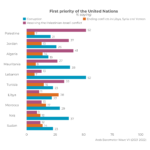The explosion at the port of Beirut killed at least 150 people, and the subsequent massive protests led to the resignation of the government. However, the protests are not about replacing the figureheads, but about addressing the ‘bankruptcy’ of the political pact that was intended to keep the religious groups in balance. The fear is great that giving up on this pact could lead to disorder and even a new civil war. However, for more than a decade, opinion polls in Lebanon have indicated that the population is unanimous in its disapproval of Lebanese politics-as-usual. A more logical vision of the future should therefore focus less on maintaining order and balance between groups and more on the accountability of leaders.
The pact
After the end of French colonisation, a pact was instituted in 1943 to not only protect the Christian majority in Lebanon – located in a predominantly Arab Muslim region – but also to give the Muslims (with roughly equal numbers of Sunnis and Shia) a substantial influence (see box). Comparisons with the Dutch ‘pillarisation’ system (the organisation of society into groups by religion and associated political beliefs) have sometimes been made, but the Lebanese system has been more rigid and has hardly moved with the times.
Even the bloody civil war (1975-1990), which had its roots in the imbalances resulting from the shift in population in favour of Muslims, led only to minor changes to the system. During the Arab uprisings of 2010-2011, the Lebanese protests mainly revolved around the dysfunctional system. As I described previously, power politics led to the nomination of Mikati (a Sunni) as prime minister, but he was primarily supported by the Shia, not the broad Sunni movement; for the Lebanese population, in particular the Sunnis, this was yet more evidence of a corrupt system that had failed in its purpose.
Undivided population
The protests of the population against the sectarian system can often be traced back to the discontent of one of the three groups (Christian, Shia or Sunni), as in the example of the Arab uprisings. However, opinion polls show that the dissatisfaction is much broader and is widely shared between groups.
The most important independent longitudinal opinion data for Lebanon comes from the Arab Barometer project, which collects representative questionnaires from Arab countries every few years. Partly on the basis of these data, I showed in a broader study of nine Arab countries that trust in political institutions was lowest in Lebanon.
In the meantime, data from 2016 and 2018 have also been collected and we can focus more specifically on the religious differences. Scores between 0 and 1 mean that the average person answers between ‘no trust at all’ and ‘limited trust’. With the exception of the Shia in 2007, [1] the averages for all groups are in this distrustful range. It is therefore not the case that Muslims have less trust because they appear to be under-represented in the political system.
If we look at the reports on the recent Arab uprisings (2010-2011) and current protests, the image could also arise that young people in particular are dissatisfied. Perhaps they protest more or use violence more often, which focuses more attention on them, but that says little about general political distrust. In the figure below , trust is broken down by age. This shows that the differences are practically imperceptible. Again, the conclusion is quite simple: political distrust is widely shared…
Read full article at Radboud Recharge

